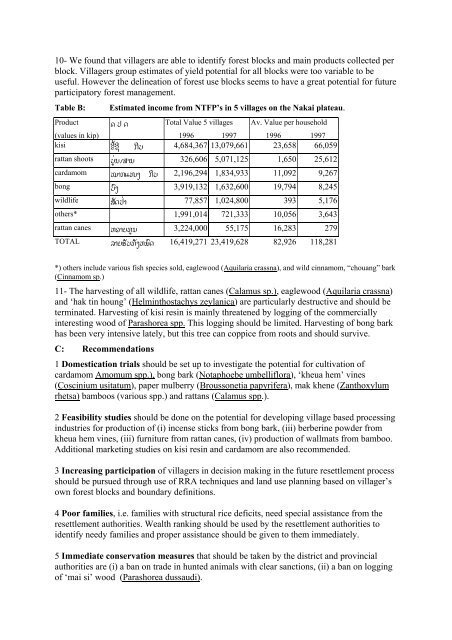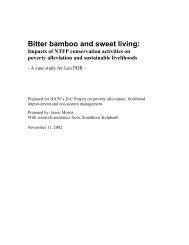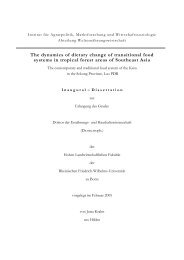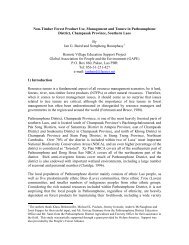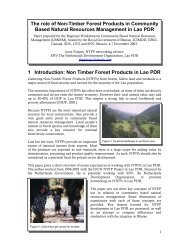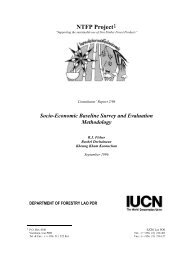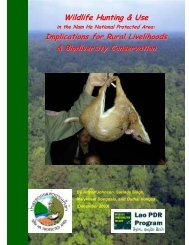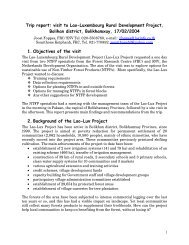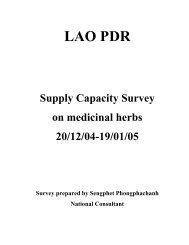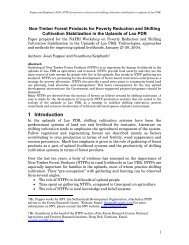Create successful ePaper yourself
Turn your PDF publications into a flip-book with our unique Google optimized e-Paper software.
10- We found that villagers are able to identify forest blocks and main products collected per<br />
block. Villagers group estimates of yield potential for all blocks were too variable to be<br />
useful. However the delineati<strong>on</strong> of forest use blocks seems to have a great potential for future<br />
participatory forest management.<br />
Table B:<br />
Estimated income from NTFP’s in 5 villages <strong>on</strong> the <strong>Nakai</strong> plateau.<br />
Product 7 x f Total Value 5 villages Av. Value per household<br />
(values in kip) 1996 1997 1996 1997<br />
kisi 0U-u du[ 4,684,367 13,079,661 23,658 66,059<br />
rattan shoots [6jo}lko 326,606 5,071,125 1,650 25,612<br />
cardamom \kdc|' du[ 2,196,294 1,834,933 11,092 9,267<br />
b<strong>on</strong>g [q' 3,919,132 1,632,600 19,794 8,245<br />
wildlife lafxjk 77,857 1,024,800 393 5,176<br />
others* 1,991,014 721,333 10,056 3,643<br />
rattan canes s;kpm6o 3,224,000 55,175 16,283 279<br />
TOTAL ]kpIa[ma's,qf 16,419,271 23,419,628 82,926 118,281<br />
*) others include various fish species sold, eaglewood (Aquilaria crassna), and wild cinnamom, “chouang” bark<br />
(Cinnamom sp.)<br />
11- The harvesting of all wildlife, rattan canes (Calamus sp.), eaglewood (Aquilaria crassna)<br />
and ‘hak tin houng’ (Helminthostachys zeylanica) are particularly destructive and should be<br />
terminated. Harvesting of kisi resin is mainly threatened by logging of the commercially<br />
interesting wood of Parashorea spp. This logging should be limited. Harvesting of b<strong>on</strong>g bark<br />
has been very intensive lately, but this tree can coppice from roots and should survive.<br />
C: Recommendati<strong>on</strong>s<br />
1 Domesticati<strong>on</strong> trials should be set up to investigate the potential for cultivati<strong>on</strong> of<br />
cardamom Amomum spp.), b<strong>on</strong>g bark (Notaphoebe umbelliflora), ‘kheua hem’ vines<br />
(Coscinium usitatum), paper mulberry (Brouss<strong>on</strong>etia papyrifera), mak khene (Zanthoxylum<br />
rhetsa) bamboos (various spp.) and rattans (Calamus spp.).<br />
2 Feasibility studies should be d<strong>on</strong>e <strong>on</strong> the potential for developing village based processing<br />
industries for producti<strong>on</strong> of (i) incense sticks from b<strong>on</strong>g bark, (iii) berberine powder from<br />
kheua hem vines, (iii) furniture from rattan canes, (iv) producti<strong>on</strong> of wallmats from bamboo.<br />
Additi<strong>on</strong>al marketing studies <strong>on</strong> kisi resin and cardamom are also recommended.<br />
3 Increasing participati<strong>on</strong> of villagers in decisi<strong>on</strong> making in the future resettlement process<br />
should be pursued through use of RRA techniques and land use planning based <strong>on</strong> villager’s<br />
own forest blocks and boundary definiti<strong>on</strong>s.<br />
4 Poor families, i.e. families with structural rice deficits, need special assistance from the<br />
resettlement authorities. Wealth ranking should be used by the resettlement authorities to<br />
identify needy families and proper assistance should be given to them immediately.<br />
5 Immediate c<strong>on</strong>servati<strong>on</strong> measures that should be taken by the district and provincial<br />
authorities are (i) a ban <strong>on</strong> trade in hunted animals with clear sancti<strong>on</strong>s, (ii) a ban <strong>on</strong> logging<br />
of ‘mai si’ wood (Parashorea dussaudi).


